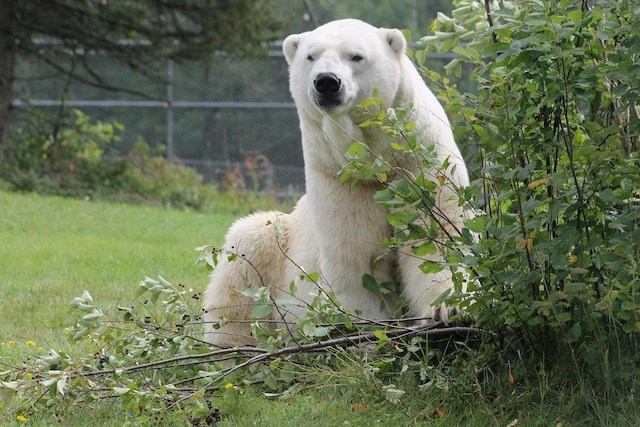COCHRANE — One of the region’s largest attractions experienced a year of progress and loss.
In 2024, the Cochrane Polar Bear Habitat was involved in advancements in research, it made progress on exhibit redesigns and celebrated its 20th anniversary. The year also saw the loss of one of its long-time residents.
One of the significant developments this year was participating in a research study testing minimally invasive tracking devices developed by Polar Bears International 3M.
In March, it was announced that the habitat’s polar bears were participating in the study. At the time, Amy Baxendell-Young, the habitat’s manager, said the tags could allow scientists to follow the movements of adult males and subadult bears, two groups that can’t be studied through current satellite collar technology.
SEE: Cochrane polar bears helping test tracking devices
She explained that the tracking devices, placed between the bear's shoulder blades, are being tested in both the wild and in human care facilities.
A sedation procedure was carried out in December 2023 to attach the devices to the three polar bears at the habitat.
The year also saw the release of two research papers involving the habitat.
“The first was a study conducted by the Centre for Conservation and Research of Endangered Wildlife at the Cincinnati Zoo, which looked at testosterone concentrations in juvenile male polar bears,” Baxendell-Young told TimminsToday.
“Our youngest bear, Henry, unknowingly contributed four years' worth of daily fecal samples to this project, which aimed to determine the age at which male polar bears reach sexual maturity.”
Another, led by Dalhousie University, looked at why polar bears in the wild have been observed eating large amounts of seaweed when on land.
“Our bears were fed a daily portion of seaweed from the Hudson Bay coast for two months, then fecal samples were collected and sent back to the university for analysis,” Baxendell-Young said.
“The purpose of this study was to gain more information on the gut microbiome of polar bears, in particular the effect of seaweed, and how their health may be impacted as they are forced to spend more time on land during the ice-free periods, when they are most likely to be eating land-based food sources.”
Infrastructure and exhibit upgrades
Thanks to provincial funding, Baxendell-Young said, significant improvements were made to the facility, including replacing roofs on five buildings — the welcome centre, viewing building, train station/fire hall, snack shack and hardware store in the heritage village.
The habitat also advanced its exhibit redesign plans. It received a $75,000 grant in October 2023, which is being used to collaborate with Science North on the redesign.
The first phase of the project focused on developing a high-level concept plan, including workshops, the development of key messages and goals and a review of existing exhibits. The habitat’s goal is to enhance the visitor experience and improve the presentation of information related to polar bear conservation.
“Working closely with Science North in Sudbury, Polar Bear Habitat staff and community representatives took part in a number of brainstorming and concept planning sessions,” Baxendell-Young said.
“These sessions were designed to capture key messaging and important information that we would like represented in a project to revitalize the educational displays on site. This project will be fully funded by donations and sponsorship, with a major campaign being launched in 2025.”
The Cochrane Polar Bear Habitat marked its 20th anniversary in August, celebrating two decades of operation since its opening in 2004.
“The Habitat has grown extensively since we first opened in 2004, and it was so wonderful to gather our supporters together to mark this momentous occasion,” Baxendell-Young said.
“The first ever Bearfest event, featuring a week of free community activities and a benefit concert was held in July, also in celebration of the Habitat's 20th anniversary. Proceeds from the benefit concert were donated to the Polar Bear Habitat.”
However, the year was also marked by the death of Inukshuk, one of the habitat’s three polar bears.
SEE: Cochrane mayor expresses condolences after death of polar bear
On Aug. 26, Inukshuk was euthanized after being diagnosed with kidney disease.
Inukshuk, who was nearly 22 years old, had been with the habitat for several years and had a long history at various institutions, including the Toronto Zoo and Zoo Sauvage.
— TimminsToday




